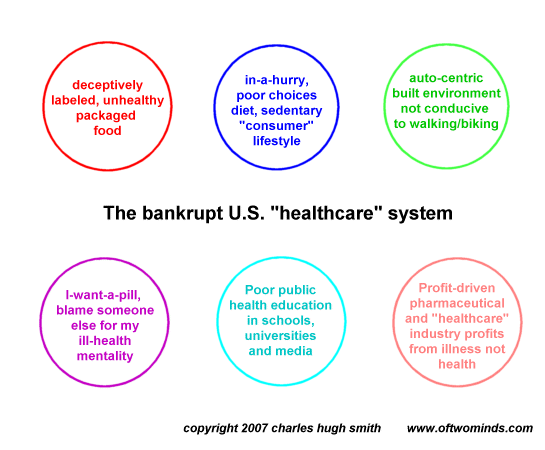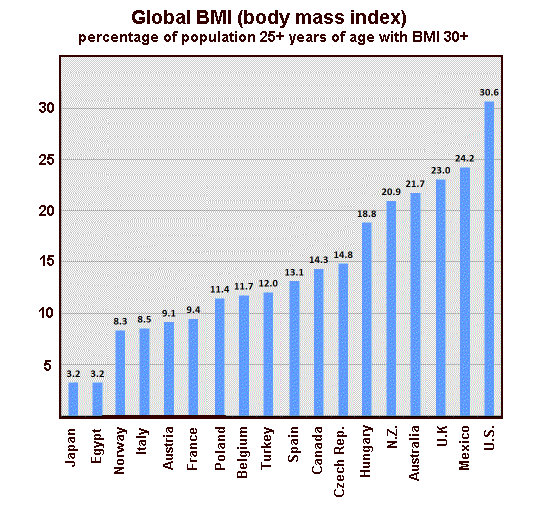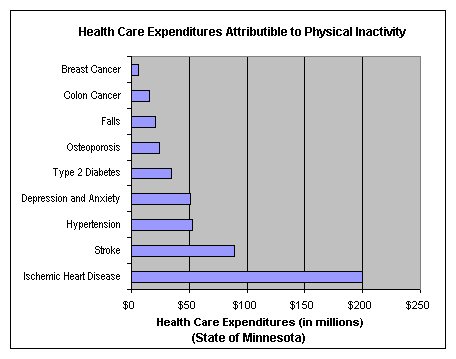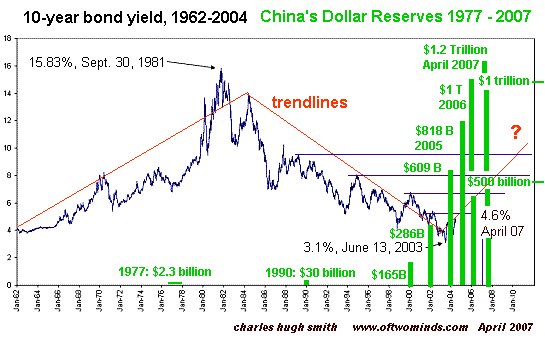The Transition to Risk
The hidden transition to ever-higher systemic risk was the major story of 2009: nothing's been fixed, and the risks of systemic failure are rising every day. On this last day of 2009, I want to address what I call the transition to risk. One analogy is the way that the risks of suffering a fatal heart attack rise in a completely hidden way. The body doesn't signal the slow accumulation of fatty deposits in arteries; the process is silent. Nor is there any conscious awareness that arteries are hardening. The accretion of risk is slow, steady, invisible--until it's too late. Some transitions to risk are highly visible. If you're driving on winding mountain roads and suddenly enter a thick fog bank which cuts your visibility to a few feet, the risks posed by continuing at high speed skyrocket. The prudent person slows down or even pulls well off the road; the imprudent person ends up a statistic. Then there are situations in which risk is building but someone with anasymmetric stake in the game convinces everyone the risk remains low to serve their own needs. The boat is leaking, the winds are rising, but the skipper's profits require completion of the passage. So he reassures the nervous passengers that everything is fine, the weather is actually improving, and the ship's pumps can easily handle the leaks. In an economy with a mainstream media controlled by a handful of corporations and a government financial policy in the hands of a few secretive manipulators, this "reassurance" comes in the form of blatant propaganda. Here is an example from today's "news": (a.k.a. disinformation) Jobless claims fall unexpectedly as layoffs ease. But the propaganda/disinformation masks the reality that it's actually 10 million people who are receiving benefits, and that number increased by 200,000: But the so-called continuing claims do not include millions of people that have used up the regular 26 weeks of benefits typically provided by states, and are receiving extended benefits for up to 73 additional weeks, paid for by the federal government. About 4.8 million people were receiving extended benefits in the week ended Dec. 12, the latest data available, an increase of 200,000 from the previous week. The rise is partly a result of another extension of benefits by Congress in November. President Obama earlier this month signed legislation that continues the extended federal benefits for the first two months of next year. That will prevent about 2 million jobless workers from running out of benefits in January and February, according to an estimate by the National Employment Law Project, a nonprofit group. Tennessee saw the largest decrease in initial claims, 2,972. So in a state with over 6 million residents, the "good news" which "proves" the economy is "rebounding" is that the "headline initial claims" number decreased by 3,000 people? This number is so small that it is in essence statistical noise. And since we weren't told how many citizens of Tennessee transitioned to extended benefits, for all we know the truth is that the number of unemployed people in TN actually rose substantially. How many people are unemployed but not receiving benefits? How many are seriously underemployed, barely scraping by on reduced hours or gutted customer contracts? By the Bureau of Labor Statistics' own estimates, this number is over 9 million. Why the real unemployment rate is far higher than the official one. (This is one of my stories over at AOL's Daily Finance site.) Toss in absurd "adjustments" such as the assumption that small businesses hired 1.2 million people that aren't counted in other surveys, and you get a real unemployment/underemployment number which is roughly double the "official" 10%. "Ladies and gentlemen, this is Captain Smith speaking. The Titanic is officially unsinkable, so while the crew clears the ice from the fore deck, go back to sleep or resume your entertainments." Here's my disassembly of the bogus GDP "headline" number which (surprise) "proves" the economy is "recovering": How Misleading Economic Data Increase Investor Risks. If the economy is "growing again," then why are sales and income taxes still falling?State, Local Tax Revenues Decline 7% By borrowing trillions of dollars and using those taxpayer funds to prop up a failed banking/speculative finance sector, the Treasury and the Fed have greatly increased the risk of systemic failure. Every day that the Federal government sells tens of billions of dollars in new debt-- and rolls over all the trillions of short-term bonds which are maturing--the risks of rapidly rising increases rates increases. Rising rates would destroy the housing market by raising the costs of mortgages. They would undermine the entire shaky regime of "cheap easy credit" which props up not just the housing market but the entire economy. Every day that the Federal, State and local government apparatchiks dissemble, obfuscate, and kick the can forward, their legitimacy declines and the concurrent risk of systemic failure increases. Every day the mainstream media prints/speaks/distributes propaganda under the guise of "official statistics" and "news," it loses legitimacy and adds to the risk of public outrage when the constant reassurances are all revealed as false. While the official line of propaganda is that the "recession ended in August or September," the reality is the systemic risk rubber band has simply been stretched to an unprecedented point of stress. In their supreme arrogance and hubris, Geithner, Bernanke and Co. are confident (or at least publicly so) that they can manipulate the smoke machines and the mirrors indefinitely. 2010 will be the year the rubber band snaps and their arrogant confidence will be revealed as the empty tricks of conjurers. Beneath the superficial reassurances and the ginned up statistics, risk has been building, slowly but relentlessly. The transition from low to high risk has been visible to those who refuse to be lulled to sleep by the official assurances. While no one knows when the rubber band will snap, those who have watched the systemic risk rise are confident it will break. Will the smoke-and-mirrors work for another year? Perhaps. But the rubber band is already refusing to stretch any more, despite the stupendous pressure being applied by the Fed and Treasury. Betting the rubber band will stretch another year is a very high-risk bet. Expanded free eBook now available (85,300 words, 136 pages): NOTE: the Kindle reader for PCs is now available for free which means you canread the Kindle version of Survival+ on your PC. Thank you, Maria K. ($25), for your exceedingly generous contribution to this site. I am greatly honored by your support and readership.The number of jobless workers continuing to claim benefits, meanwhile, dropped by 57,000 to 4.9 million, also better than the increase that analysts expected. This supports the "headline" propaganda: "Jobless claims fall unexpectedly as layoffs ease."
Permanent link: The Transition to Risk
NOTE ON THE SURVIVAL+ BOOK: I am reformatting the interior for improved readability, so the book will not be available for the next few days. Your patience will be rewarded with a new cover and more readable text.
in HTML: Survival+ in PDF: Survival+
Of Two Minds is now available via Kindle: Of Two Minds blog-Kindle






























